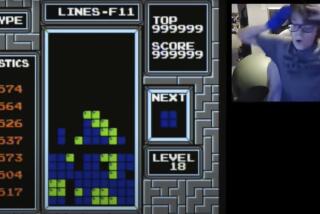By a twist of fate, he found his passion early
- Share via
They met at a mall and Ryan Patricio sensed the chemistry immediately. He was drawn to it, called by it and he knew -- perhaps they both did -- that he would ultimately possess it.
“You know when you meet someone and really click with them?” he asked. “Well, that’s what happened.”
And click he did. And click some more.
The possibilities -- all 43 quintillion of them -- seemed endless.
Then, after months of manipulation, he broke down its defenses, and the rest is Rubik’s Cube history.
Patricio didn’t just crack the maddening puzzle, he became a star “cuber” in the process. He could do it fast, do two at a time, do it one-handed, even do it blindfolded.
He performed at high school pep rallies and at 16 broke the world record by outwitting the cube in 31 seconds.
Last month, the 18-year-old Temecula resident did it in a mere 14.17 seconds to win the U.S. Open Rubik’s Cube Championship in Chicago, making him national champion. His trophy, a Rubik’s Cube enclosed in a bigger, transparent cube, now sits in his living room beside other cube-within-cube awards. His next stop is Budapest, Hungary, for the world championship in October.
But if Patricio has a secret, he isn’t telling. He says he isn’t all that good at math, isn’t an especially great student and, despite his fixation on the cube, isn’t a square.
“Maybe it’s my hands; they’re 8 inches in diameter,” he says, holding them up for inspection. “Maybe you’re just born for it.”
He grabs a cube and the hands blur. Seconds later the jumbled puzzle is properly assembled and Patricio is stifling a yawn.
His highly focused yet easygoing demeanor gives him a sort of Mr. Spock-meets-surfer-dude aspect.
How are competitions done?
“There is a judge and a clock, and you go up there and do it,” he said laconically, a sucker protruding from his mouth.
Is there a system?
“There’s the Rux method, the corners-first method, the Waterman method, which is really an advanced corners-first method,” he explained precisely. “I learned the Fridrich method, which is to do a ‘T’ then do the four corners, then the first two layers. I memorized 57 algorithms. There are 21 patterns you’ll see. Then you solve it. It took me half a year to learn the method. I don’t know why I did it; it’s just one of those things.”
Patricio’s muse is Jessica Fridrich, a professor of engineering at the State University of New York at Binghamton. In 1983, she developed arguably the fastest method of solving the cube, a technique that has spread around the globe. She once placed second in the world championships in Toronto.
“It was all trial and error,” she said. “The puzzle is an interesting combination of intellectual and physical abilities. It’s a complex system of algorithms. I would say it would be impossible to hate math and love the cube, but at the same time you do not have to be mathematically oriented.”
“You need to be captured by the cube,” she said.
At a competition in Budapest, Fridrich scored the Holy Grail of cubers -- she got the autograph of Erno Rubik, the Hungarian who invented the puzzle in 1974.
When “warmed up,” she said, she can decipher the cube in about 18 seconds.
“There is a big difference between 18 seconds and 14 seconds, and I have heard of someone now averaging 11 seconds,” she said. “Never in my dreams would I have imagined this to be possible. If you want to be a top cuber you have to put a lot of time into it. You have to have the desire, the passion and the disease.”
The disease?
“You have to be a little crazy,” she said.
The resolutely low-tech toy is enjoying something of a renaissance. It figured prominently in the movie “The Pursuit of Happyness” when actor Will Smith landed a job after impressing a high-flying businessman by doing the puzzle during a shared cab ride.
Hasbro, which distributes the puzzle, said each cube has 43,252,003,274,489,856,000 possible combinations.
They have sold 250 million cubes since it hit the market in 1980, and sales are again skyrocketing.
“We are seeing an increase of 100% to 200% in sales this year versus last year,” said Matt Collins, vice president of marketing for the company.
He attributes much of the popularity to the movie, to the fact that anything “retro” is in vogue and to parents eager to challenge their kids’ minds.
Collins, who has never beaten the puzzle, attended the national championships and came away humbled.
“You had college kids from the best engineering schools in the country competing. There were people solving the cube with blindfolds on,” he said. “They would study the sides first and figure out the formula and how many clicks it would take. You had to see it to believe it.”
In the end it was Patricio, a recent high school graduate now considering community college, who won the title.
He practices an hour a day, saying anything more is pointless. But concentration, he allows, is critical.
“I sit down in a chair and I block everything out. I have no peripheral vision at that point, and that helps you focus,” he said. “I know one guy who went to hypnotherapy to help him block out the audience.”
He also keeps a file of statistics about competitors worldwide.
“Jean Pons of France is the current world champion at 13.13 seconds,” he said. “But people say I’m favored to win.”
If he does win, Patricio will get about $6,500 in cash. After that he plans on riding the cube as far as possible. If he can’t get his face on a cereal box, he might at least land a gig with a game developer.
“If I win, there will be loads of media attention,” he said confidently. “It will open a lot of doors, and I’ll just go wherever it takes me.”


